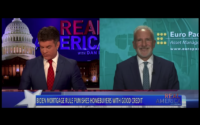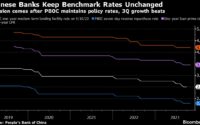The financial system is in a slow-motion meltdown. There are many indications that the economy’s in trouble, despite what you’ll hear from the cheerleaders in the mainstream media.
Commercial real estate values are crashing, and the associated loans are going into default. Credit cards are maxed out and borrowers are being punished with 20% or even 30% interest rates (that will double the outstanding balance in three years if you don’t pay it off).
There’s a global dollar shortage, which explains why China is dumping U.S. Treasury securities (to get cash) and why the euro, yen, yuan and sterling are all going down against the dollar.
Meanwhile, investors are bracing for Stage Two of the banking crisis (Stage One consisted of the failures of Silvergate, Silicon Valley, Signature, Credit Suisse and First Republic from March 9 to May 1, 2023).
In fact, I believe the situation is so urgent that I held an emergency event last week to alert my readers about it.
There are plenty of other indicators out there that show expectations of a sharp recession and global financial crisis. Some are very technical in nature, so I won’t get into them here.
So can things get any worse? Actually, yes, they can.
Even the Fed’s Losing Money!
Not only are banks and consumers losing money, but the Federal Reserve System itself is losing money. The Fed has recently lost over $100 billion to be exact. How does this happen?
The Fed may be a central bank, but it’s still a bank with assets and liabilities like any other. The Fed makes money from interest payments on the U.S. Treasury securities it holds. It pays money in the form of interest on excess reserves (IOER) that are deposited with the Fed by the big banks.
The Treasury yield curve is inverted right now. This means that interest rates on short-term instruments (such as IOER) are actually higher than interest rates on longer-term instruments (such as Treasury notes). This negative interest rate spread is even more extreme when the U.S. Treasury notes held were issued in 2021 or 2022 when rates were much lower than they are today.
When you pay about 5% on your liabilities (IOER) and you only earn about 3% on your assets (Treasury notes) and you multiply that by a $5 trillion balance sheet, you can see the problem.
In fact, analysts estimate that the Fed may lose $200 billion next year as the problem persists because the Fed has offered to lend money against any U.S. Treasury notes held by member banks at par value even when the notes are only worth 70% of par.
This is not happening in isolation. The Fed is required to remit its profits to the U.S. Treasury. When the profits turn into losses (as they have), this means the Treasury is losing its distributions from the Fed, which makes the U.S. budget deficit even worse.
It looks like hard times all around, but it’s especially hard when you realize the Fed and Treasury are among the big losers in this meltdown.
But the Fed has gotten inflation under control, right? Well, not so fast…
The Fed’s Premature Victory
Inflation as measured by the Consumer Price Index (CPI) hit a high of 9.1% (annualized) in June 2022.
Since then, the Fed made steady progress in reducing inflation until it was down to 3.0% by this June. Economists and Fed fans were ready to pop the Champagne corks to celebrate the Fed’s victory against inflation.
The Fed’s target rate is 2.0%, so the 3.0% reading seemed just an inch away. Then a funny thing happened.
Inflation rose to 3.2% in July. Then it soared to 3.7% in August. We won’t have the September numbers until Oct. 12, but they’re very likely to be higher again because the recent inflation has been driven by energy prices and oil keeps going up.
Oil prices have topped $91.00 per barrel, up from $67.00 per barrel as recently as June 27. That’s a 36% spike in less than three months, which is dramatic. Those wholesale price spikes have not worked their way through the supply chain yet, so it’s reasonable to expect further CPI increases based on gasoline prices in September and October.
In short, the Fed’s victory is in shambles, and they must now double down on rate hikes to get inflation back under control in time for the elections in 2024.
But it may be more difficult to do that than the Fed imagines. The reason has to do with consumer expectations. So far, inflation has come from supply side disruption due to trade wars, the pandemic, and financial sanctions due to the war in Ukraine.
That kind of inflation tends to control itself as consumers spend less on discretionary items to deal with higher prices on necessities. The danger is that the inflation impetus jumps from the supply side to the demand side.
At that point, consumers expect inflation across the board and accelerate purchases of all kinds to beat the anticipated price hikes. This happened in the late 1970s when supply side inflation (the Arab oil embargo) morphed into demand side inflation (runaway price increases in 1979–1981).
We’re not quite there yet, but the danger is real. Jay Powell knows this and will raise rates sometime this year (probably at the November meeting, but not the meeting coming up this week) to keep things under control.
Markets have not priced in another rate hike. So markets not only have to confront the very real possibility of a sharp recession and severe financial crisis. They also have to confront the prospect of at least one additional rate hike this year.
The Silver Lining
If you’re looking for some good news, here it is:
In case of a severe recession, the Fed will begin cutting rates again. As a rule, the Fed needs interest rates to be between 4% and 5% to fight recession. That’s how much “dry powder” the Fed needs going into a recession.
The Fed’s target rate is presently between 5.25–5.50%. If they raise rates again, which I expect, their target rate will be even higher. That means the Fed will have plenty of room to cut interest rates in order to fight a recession, without having to resort to negative interest rates.
So that’s the good news. The bad news is that the Fed’s probably going to need most of that dry powder.
Investors beware.


